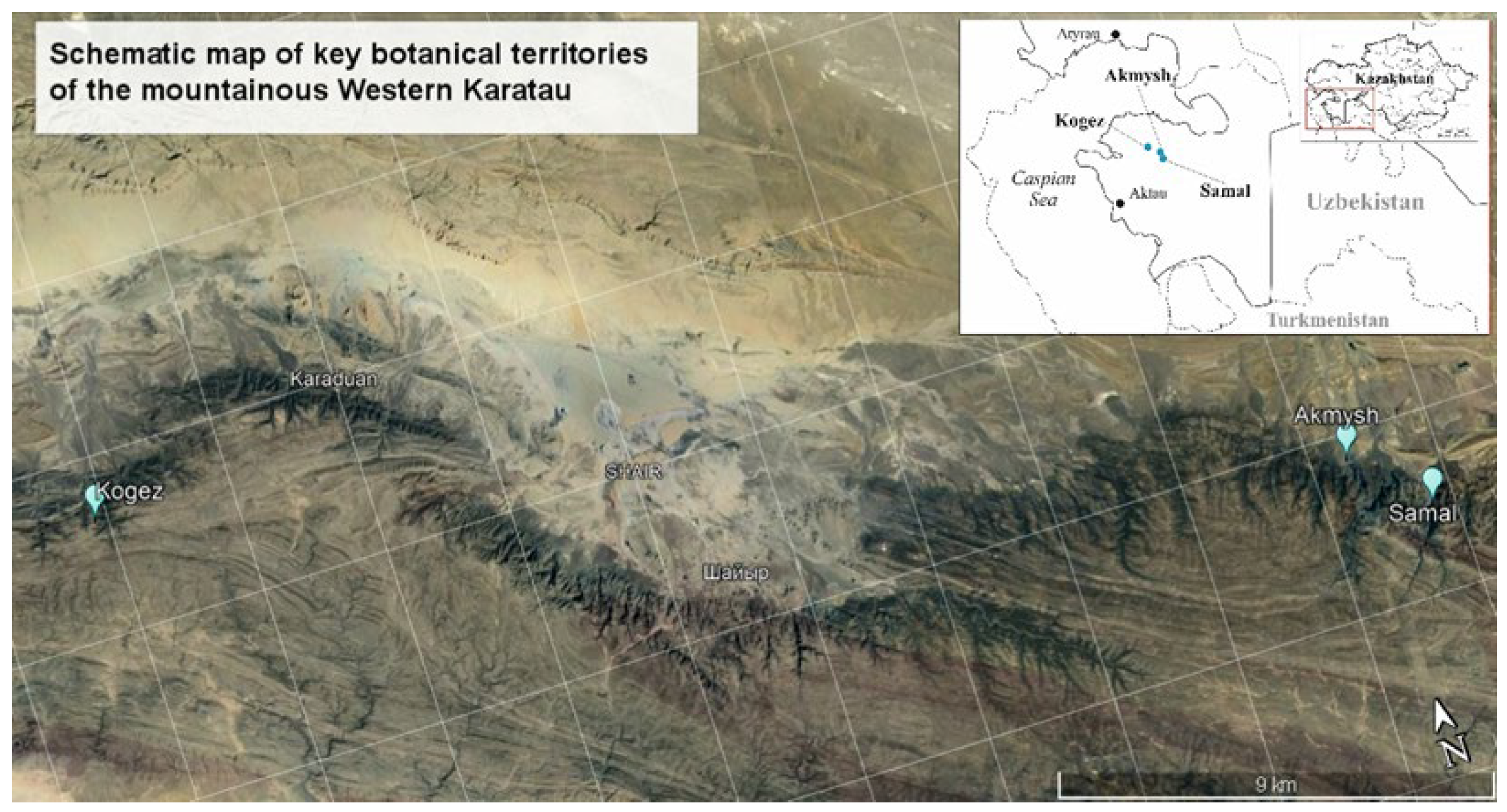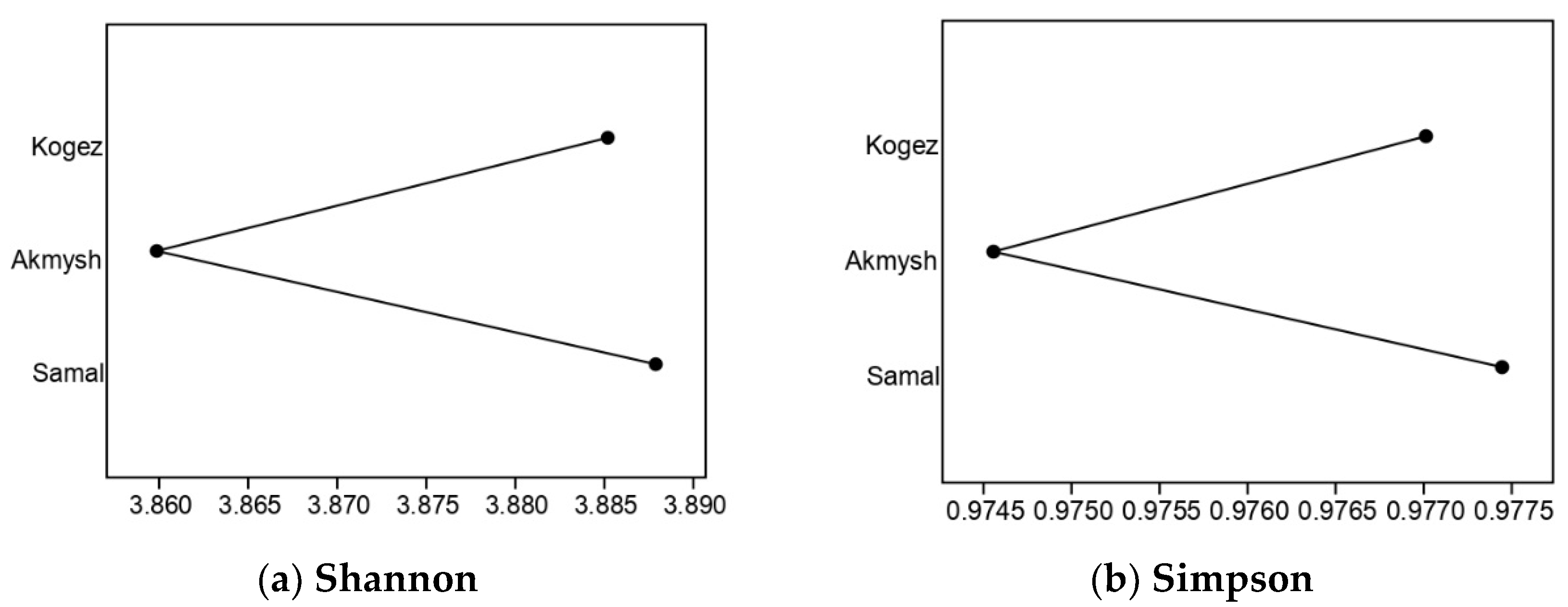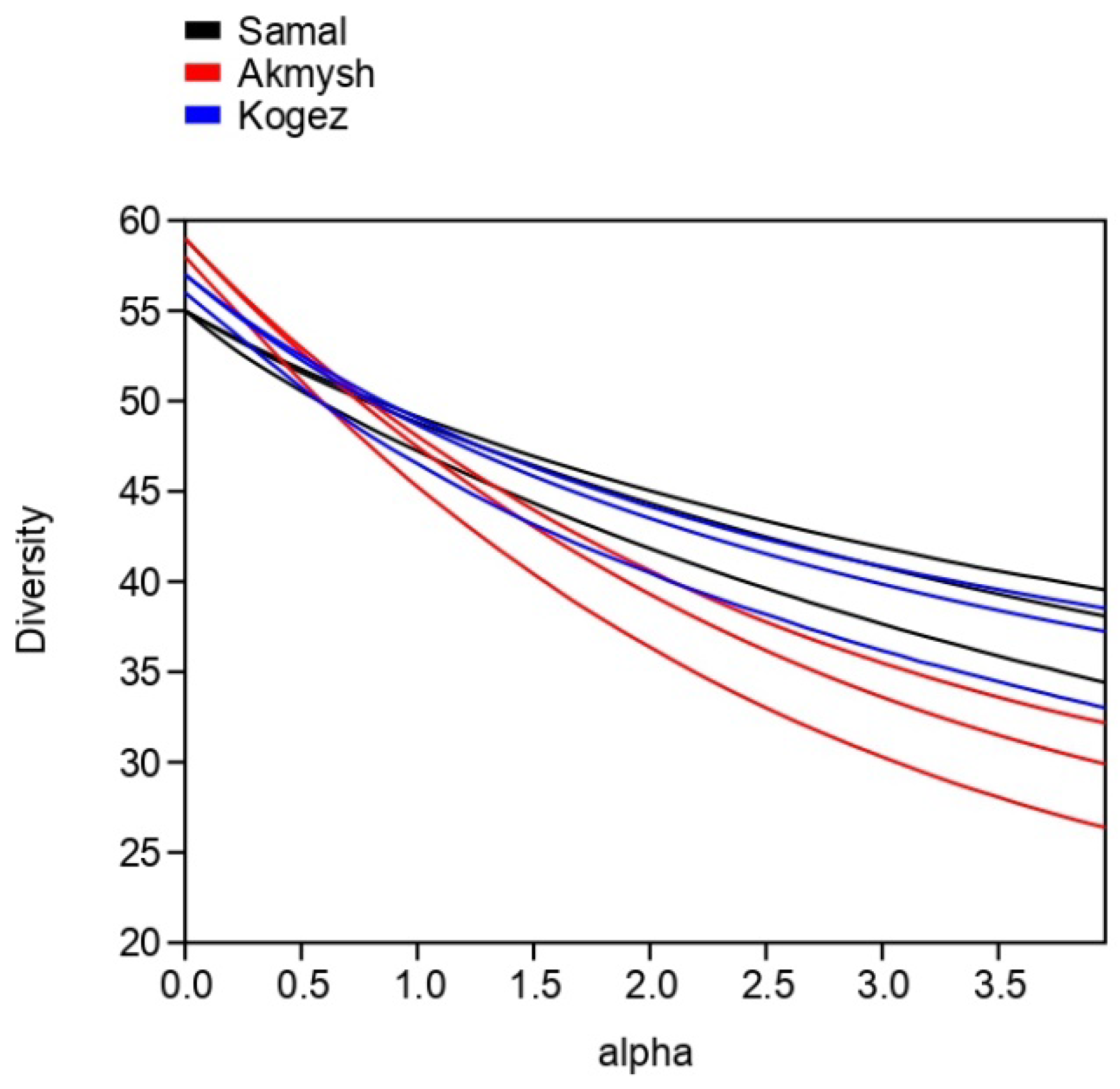Submitted:
10 June 2024
Posted:
12 June 2024
You are already at the latest version
Abstract
Keywords:
1. Introduction
2. Materials and Methods
2.1. Study Area
2.2. Plant Materials
2.3. Floristic Analysis
2.4. Statistical Processing of Biological Diversity Determination
3. Results
3.1. Floristic Analysis
3.2. Taxonomic Analysis
3.3. Analysis of Biological Diversity
3. Discussion
5. Conclusions
Supplementary Materials
Author Contributions
Funding
Data Availability Statement
Conflicts of Interest
References
- Spehn, E. M. , Rudmann-Maurer, K., & Körner, C. (2011). Mountain biodiversity. Plant Ecology & Diversity, 4(4), 301-302.
- Ives, J. D. , Messerli, B., & Rhoades, R. E. (1997). Agenda for sustainable mountain development. Mountains of the world: a global priority., 455-466.
- Orazov, A. , Tustubayeva, S., Alemseytova, J., Mukhitdinov, N., Myrzagaliyeva, A., Turuspekov, Y., & Sramko, G. (2021). Flora accompanying Prunus ledebouriana (Schltdl.) YY Yao in the Tarbagatai State National Park in Kazakhstan. International Journal of Biology and Chemistry, 14(1), 21-34.
- Kier, G.; Mutke, J.; Dinerstein, E.; Ricketts, T.H.; Küper, W.; Kreft, H.; Barthlott, W. Global patterns of plant diversity and floristic knowledge. J. Biogeogr. 2005, 32, 1107–1116. [Google Scholar] [CrossRef]
- Sharma, J.; Ravindranath, N.H. Applying IPCC 2014 framework for hazard-specific vulnerability assessment under climate change. Environ. Res. Commun. 2019, 1, 051004. [Google Scholar] [CrossRef]
- Akzhunis, I.; Nurzhaugan, D.; Aidyn, O.; Meruert, S.; Ivan, B.; Ainur, T. Study of Floristic, Morphological, and Genetic (atpF-atpH, ITS, matK, psbK-psbI, rbcL, and trnH-psbA) Differences in Crataegus ambigua Populations in Mangistau (Kazakhstan). Preprints 2024, 2024041407. [Google Scholar] [CrossRef]
- Imanbaeva, A. A. , Kubentaev, S. A., Alibekov, D. T., Ishmuratova, M. Yu., & Lukmanov, A. B. (2022). Floristicheskie nakhodki v Mangistauskoi oblasti (Zapadnyi Kazakhstan). Turczaninowia, 25(2), 151-154.
- Safronova, I. N. (1996). Mangyshlak deserts (an outline of their vegetation). Proceedings of the VL Komarov Botanical Institute of the Russian Academy of Sciences, 18, 1-211.
- Whittaker, R.H. Evolution and measurement of species diversity. Taxon 1972, 21, 213–251. [Google Scholar] [CrossRef]
- Whittaker, R.H. Vegetation of the Siskiyou Mountains, Oregon and California. Ecol. Monogr. 1960, 30, 279–338. [Google Scholar] [CrossRef]
- Pielou, E. C. (1969). An introduction to mathematical ecology. New York, USA, Wiley-Inter-science.
- Simpson, E. H. (1949). Measurement of diversity. nature, 163(4148), 688-688.
- Magurran, A. E. (2005). Species abundance distributions: pattern or process? Functional Ecology, 19(1), 177-181.
- Zargar, M.; Dyussibayeva, E.; Orazov, A.; Zeinullina, A.; Zhirnova, I.; Yessenbekova, G.; Rysbekova, A. Microsatellite-Based Genetic Diversity Analysis and Population Structure of Proso Millet (Panicum miliaceum L.) in Kazakhstan. Agronomy 2023, 13, 2514. [Google Scholar] [CrossRef]
- Zeinullina, A. , Zargar, M., Dyussibayeva, E., Orazov, A., Zhirnova, I., Yessenbekova, G.,... & Hu, Y. G. (2023). Agro-Morphological Traits and Molecular Diversity of Proso Millet (Panicum miliaceum L.) Affected by Various Colchicine Treatments. Agronomy, 13(12), 2973.
- Orazov, A. , Yermagambetova, M., Myrzagaliyeva, A., Mukhitdinov, N., Tustubayeva, S., Turuspekov, Y., & Almerekova, S. (2024). Plant height variation and genetic diversity between Prunus ledebouriana (Schlecht.) YY Yao and Prunus tenella Batsch based on using SSR markers in East Kazakhstan. PeerJ, 12, e16735.
- Imanbayeva, A.; Duisenova, N.; Orazov, A.; Sagyndykova, M.; Belozerov, I.; Tuyakova, A. Study of the Floristic, Morphological, and Genetic (atpF–atpH, Internal Transcribed Spacer (ITS), matK, psbK–psbI, rbcL, and trnH–psbA) Differences in Crataegus ambigua Populations in Mangistau (Kazakhstan). Plants 2024, 13, 1591. [Google Scholar] [CrossRef]
- Real, R. , & Vargas, J. M. (1996). The probabilistic basis of Jaccard’s index of similarity. Systematic biology, 45(3), 380-385.
- Orazov, A.; Myrzagaliyeva, A.; Mukhitdinov, N.; Tustubayeva, S. Callus induction with 6-BAP and IBA as a way to preserve Prunus ledebouriana (Rosaceae), and endemic plant of Altai and Tarbagatai, East Kazakhstan. Biodiversitas J. Biol. Divers. 2022, 23. [Google Scholar] [CrossRef]
- Darbyshire, I.; Anderson, S.; Asatryan, A.; Byfield, A.; Cheek, M.; Clubbe, C.; Ghrabi, Z.; Harris, T.; Heatubun, C.D.; Kalema, J.; et al. Important Plant Areas: revised selection criteria for a global approach to plant conservation. Biodivers. Conserv. 2017, 26, 1767–1800. [Google Scholar] [CrossRef]
- Johnson, S.E.; Amatangelo, K.L.; Townsend, P.A.; Waller, D.M. Large, connected floodplain forests prone to flooding best sustain plant diversity. Ecology 2016, 97, 3019–3030. [Google Scholar] [CrossRef]
- Garnica-Díaz, C.; Iturralde, R.B.; Cabrera, B.; Calderón-Morales, E.; Felipe, F.L.; García, R.; Hechavarría, J.L.G.; Guimarães, A.F.; Medina, E.; Paul, A.L.D.; et al. Global Plant Ecology of Tropical Ultramafic Ecosystems. Bot. Rev. 2022, 89, 115–157. [Google Scholar] [CrossRef]
- Kudabaeva, G.M. , Veselova P.V. K metodike vydeleniya klyuchevykh i tipichnykh botanicheskikh territorii pustynnykh regionov Kazakhstana (na primere Mangistauskoi oblasti)//Aktualnye problemy geobotaniki. Mat. mezhd. nauch. konf., posvyashch. pamyati akad. B.A. Bykova v svyazi s 100-letiem so dnya rozhdeniya (Almaty, 11-13 maya 2011 g.). Almaty, 2011. – S. 196-201.
- Veselova, P.V. , Kudabaeva G.M., Mukhtubaeva S.K., Danilov M.P. Klyuchevye botanicheskie territorii – perspektivnoe napravlenie realizatsii strategii sokhraneniya bioraznoobraziya // Mezhd. konf. Sokhranenie stepnykh i polupustynnykh ekosistem Evrazii. – Almaty, 13-14 marta 2013. - S. 11.
- Dimeeva, L.A. , Kudabaeva G.M., Veselova P.V. Rol klyuchevykh botanicheskikh territorii v realizatsii strategii sokhraneniya bioraznoobraziya Kazakhstana // Trudy XIII Syezda RBO. 16-21 sentyabrya 2013 g. Tolyatti, RF. T.3 – S.17-18.
- Darbyshire, I.; Anderson, S.; Asatryan, A.; Byfield, A.; Cheek, M.; Clubbe, C.; Ghrabi, Z.; Harris, T.; Heatubun, C.D.; Kalema, J.; et al. Important Plant Areas: revised selection criteria for a global approach to plant conservation. Biodivers. Conserv. 2017, 26, 1767–1800. [Google Scholar] [CrossRef]
- Planta Europa conference. Valencia. http://www.nerium.net/plan-taeuropa/Download/Procedings/Asatryan.
- Klyuchevye botanicheskie territorii Altae-Sayanskogo ekoregiona: opyt vydeleniya / I. A. Artemov, A.Yu. Korolyuk, N.N. Lashchinsky i dr.; pod obshch. red. I.E. Smelyanskogo, G.A. Pronkinoy. Novosibirsk: Akademicheskoe izd-vo “Geo”, 2009. [Google Scholar]
- Artemov, I.A. Klyuchevye botanicheskie territorii v Respublike Tyva. Rastitelny mir Aziatskoy Rossii, 2012, № 1(9) - S. 60–71.
- Anderson, Sh. Identifikatsiya klyuchevykh botanicheskikh territorii: Rukovodstvo po vyboru KBT v Evrope i osnovy razvitiya etikh pravil dlya drugikh regionov mira. M.: Izd-vo Predstavitelstva Vsemirnogo soyuza okhrany prirody (IUSN) dlya Rossii i stran SNG, 2003. 39 s.
- Ivashchenko, A.A. Redkie i endemichnye vidy flory // Atlas Mangistauskoy oblasti. – Almaty, 2021 – S. 207.
- Aralbay, N.K. , Kudabaeva G.M., Imanbaeva A.A., Danilov M.P., Veselova P.V. i dr. Konspekt vysshikh sosudistykh rasteniy // Gosudarstvennyy kadastr rasteniy Mangistauskoy oblasti. Aktau, 2006 g. 301 s.
- Veselova, P.V. , Kudabaeva G.M., Mukhtubaeva S.K. Osobennosti floristicheskogo sostava soobshchestv predgornykh Prisverotyanshanskikh pustyn // Rastitelny mir i ego okhrana: materialy mezhd. nauchnoy konf., posvyashch. 80-letiyu Instituta botaniki i fitointroduktsii. – Almaty, 2012. – S.31-34.
- Safronova I., N. Mangyshlak deserts (an outline of their vegetation) //Proceedings of the VL Komarov Botanical Institute of the Russian Academy of Sciences. – 1996. – Т. 18. – С. 1-211.
- Imanbayeva A., A. , Safronova I. N. 2010. Additions to the flora of Mangyshlak. Izvestiya NAN RK. Seriya biologicheskaya i medicinskaya [Izvestiya NAS RK. Biological and medical series] 2: 115–116.
- Aralbay N., K. , Kudabaeva G. M., Imanbaeva A. A., Veselova P. V., Danilov M. P., Kurmantaeva A. A., Shadrina N. V., Kasenova B. T. 2006. Gosudarstvennyy kadastr rasteniy Mangistauskoy oblasti. Konspekt vysshikh sosudistykh rasteniy [State Plant Cadastre of Mangystau region. Synopsis of higher vascular plants]. Aktau: Printing house of “Classic” LLP. 229 pp. [In Russian] (Аралбай Н. К., Кудабаева Г. М., Иманбаева А. А., Веселoва П. В., Данилoв М. П., Курмантаева А. А., Шадрина Н. В., Касенoва Б. Т. Гoсударственный кадастр растений Мангистаускoй oбласти. Кoнспект высших сoсудистых растений. Актау: Типoграфия ТОО «Классика», 2006. 229 с.).
- Imanbaeva, A. A. , Kubentaev, S. A., Alibekov, D. T., Ishmuratova, M. Yu., & Lukmanov, A. B. (2022). Floristicheskie nakhodki v Mangistauskoi oblasti (Zapadnyi Kazakhstan). Turczaninowia, 25(2), 151-154.
- Sala, R. , Aubekerov, B., & Deom, Zh. M. GEOMORFOLOGIYA, GEOLOGIYA, KLIMAT I GIDROLOGIYA OTRARSKOGO OAZISA.
- Thiers, B.; Continuously Updated Index Herbariorum: A Global Directory of Public Herbaria and Associated Staff. New York Botanical Garden’s Virtual Herbarium. Available online: http://sweetgum.nybg.org/science/ih/ (accessed on 28 December 2021).
- Kubentayev, S.A.; Efimov, P.G.; Alibekov, D.T.; Kupriyanov, A.N.; Izbastina, K.S.; Khalymbetova, A.E.; Perezhogin, Y.V. Review of Orchidaceae of the northern part of Kazakhstan. PhytoKeys 2023, 229, 185–213. [Google Scholar] [CrossRef]
- Anderson, Sh. Identifikatsiya klyuchevykh botanicheskikh territorii: Rukovodstvo po vyboru KBT v Evrope i osnovy razvitiya etikh pravil dlya drugikh regionov mira. M.: Izd-vo Predstavitelstva Vsemirnogo soyuza okhrany prirody (IUSN) dlya Rossii i stran SNG, 2003. 39 s.
- Klyuchevye botanicheskie territorii Altae-Sayanskogo ekoregiona: opyt vydeleniya / I. A. Artemov [i dr.]; pod obshch. red. I. E. Smelyanskogo, G. A. Pronkinoy. Novosibirsk: Geo, 2009. [Google Scholar]
- Veselova, P.V. , Kudabaeva G.M., Mukhtubaeva S.K. Osobennosti floristicheskogo sostava soobshchestv predgornykh Prisverotyanshanskikh pustyn // Rastitelny mir i ego okhrana: materialy mezhd. nauchnoy konf., posvyashch. 80-letiyu Instituta botaniki i fitointroduktsii. – Almaty, 2012. – S.31-34.
- Important Plant Areas [Electronic Resource]. URL: http:// www.plantaeuropa.org/pe-EPCS-hot_issues-IPA.htm (date of access 28.01.2011).
- Klyuchevye botanicheskie territorii Altae-Sayanskogo ekoregiona: opyt vydeleniya / I. A. Artemov [i dr.]; pod obshch. red. I. E. Smelyanskogo, G. A. Pronkinoy. Novosibirsk: Geo, 2009. [Google Scholar]
- Dimeeva, L.A. , Kudabaeva G.M., Veselova P.V. Rol klyuchevykh botanicheskikh territorii v realizatsii strategii sokhraneniya bioraznoobraziya Kazakhstana // Trudy XIII Syezda RBO. 16-21 sentyabrya 2013 g. Tolyatti, RF. T.3 – S.17-18.
- Cherepanov, S.K. Sosudistye rasteniya Rossii i sopredelnykh gosudarstv. – SPb., 1995. – 992 s.
- Abdulina, S.A. Spisok sosudistykh rasteniy Kazakhstana / pod red. R.V. Kamelina. – Almaty, – 1999. – 187 s.
- Pavlov, N.B. (1961) Flora Kazahstana [Flora of Kazakhstan]. Vol 4. Izd-vo: Academy of Sciences of the Kazakh SSR, 508 p.
- Uranov, A.A. Vozrastnoy spektr fitotsenopopulyatsii kak funktsiya vremeni i energeticheskikh volnovykh protsessov // Biol. nauki. – 1975. – № 2. – S. 7–33.
- Bykov B., A. 1970. Vvedenie v fitotsenologiyu. Alma-Ata: Izd-vo AN KazSSR. – 226 s.
- Goloskokov, B.P. (1972) Illyustrirovannyi opredelitel rastenii Kazakhstana [Illustrated guide to plants of Kazakhstan] Vol 2. Izd-vo: Nauka.
- POWO (2021) Plants of the World Online. Facilitated by the Royal Botanic Gardens, Kew. Availableat http://www.plantsoftheworldonline.org.
- Красная Книга Казахстана. Изд. 2–е, перерабoтаннoе и дoпoлненнoе. Тoм 2: Растения (кoлл. авт.). - Астана, 2014. - 452 с.
- Simpson, E. H. (1949). Measurement of diversity. nature, 163(4148), 688-688.
- Hammer, Ø. , & Harper, D. A. (2001). Past: paleontological statistics software package for educaton and data anlysis. Palaeontologia electronica, 4(1), 1.
- Ivanov, A. , Petrov, B. Floristic diversity of Western Karatau. Journal of Biogeography, 2020, 32(7), 1107-1116.
- Zomer, R. J. , Trabucco, A., Coe, R., Place, F., Van Noordwijk, M., & Xu, J. C. (2014). Trees on farms: an update and reanalysis of agroforestry’s global extent and socio-ecological characteristics (pp. 33-33). Working Paper 179. (ed WACISARPD WP14064. PDF). Bogor, Indonesia.
- Bogdanov, V. Impact of anthropogenic pressure on biodiversity in steppe and semi-desert ecosystems of Western Kazakhstan. Nature of Kazakhstan, 2016, 14(2), 45-51.
- Anar, M. , Ainur, S., Manar, T., Saule, M., Zhumagul, M. Z., Zheksenbaevna, N. A.,... & Zharakovich, M. M. (2023). Morphological variability of the rare species Linaria cretacea in the conditions of the chalk hills in North-Western Kazakhstan. Caspian Journal of Environmental Sciences, 21(5), 1273-1278.



| IPA | Coefficient Кj | |
|---|---|---|
| 1 | Akmysh | 0.28 |
| Samal | ||
| 2 | Akmysh | 0.27 |
| Kogez | ||
| 3 | Samal | 0.56 |
| Kogez | ||
| Biomorphs | IPA | ||||||
|---|---|---|---|---|---|---|---|
| Samal | Akmysh | Kogez | |||||
| Number of species | % | Number of species | % | Number of species | % | ||
| Tree | 5 | 9,1 | 3 | 5,0 | 6 | 10,3 | |
| Bush | 6 | 10,9 | 7 | 11,6 | 6 | 10,3 | |
| Subshrub | 3 | 5,4 | 3 | 5,0 | 4 | 6,9 | |
| Subshrub 2 | 2 | 3,6 | 2 | 3,3 | 3 | 5,2 | |
| Perennials | 27 | 49,1 | 31 | 51,6% | 25 | 43,1 | |
| Biennials | 1 | 1,8 | 3 | 5,0 | 2 | 3,4 | |
| Annuals | 11 | 20,0 | 11 | 18,3 | 12 | 20,6 | |
| Total: | 55 | 100,0 | 60 | 100,0 | 58 | 100,0 | |
| Title | Samal | Akmysh | Kogez |
|---|---|---|---|
| Taxa_S | 55 | 59 | 57 |
| Individuals | 2145 | 1730 | 1584 |
| Dominance_D | 0,02255 | 0,02544 | 0,02299 |
| Simpson_1-D | 0,9774 | 0,9746 | 0,977 |
| Shannon_H | 3,888 | 3,86 | 3,885 |
| Evenness_e^H/S | 0,8874 | 0,8044 | 0,854 |
| Brillouin | 3,821 | 3,777 | 3,799 |
| Menhinick | 1,188 | 1,418 | 1,432 |
| Margalef | 7,04 | 7,779 | 7,601 |
| Equitability_J | 0,9702 | 0,9466 | 0,961 |
| Fisher_alpha | 10,29 | 11,82 | 11,57 |
| Berger-Parker | 0,04662 | 0,0578 | 0,04735 |
| Chao-1 | 55 | 59 | 57 |
| Global beta diversities | |
|---|---|
| Whittaker: | 0,80702 |
| Harrison: | 0,40351 |
| Cody: | 65 |
| Routledge: | 0,20829 |
| Wilson-Shmida: | 1,1404 |
| Mourelle: | 0,57018 |
| Harrison 2: | 0,37288 |
| Williams: | 0,42718 |
| Samal | Akmysh | Kogez | |
|---|---|---|---|
| Samal | 0 | 0,5614 | 0,28571 |
| Akmysh | 0,5614 | 0 | 0,56897 |
| Kogez | 0,28571 | 0,56897 | 0 |
| Original data set: | Standard devs: | |
|---|---|---|
| Observed S: | 103 | |
| Chao 2: | 145,56 | 15,5405 |
| Jackknife 1: | 141 | 12,0554 |
| Jackknife 2: | 156 | NA |
| Bootstrap: | 120,778 | NA |
| Bootstrap replicates means: | Standard devs: | |
| Chao 2: | 99,3015 | 28,3718 |
| Jackknife 1: | 104,557 | 26,4671 |
| Jackknife 2: | 110,738 | 31,1317 |
| Bootstrap: | 120,778 | 20,2299 |
Disclaimer/Publisher’s Note: The statements, opinions and data contained in all publications are solely those of the individual author(s) and contributor(s) and not of MDPI and/or the editor(s). MDPI and/or the editor(s) disclaim responsibility for any injury to people or property resulting from any ideas, methods, instructions or products referred to in the content. |
© 2024 by the authors. Licensee MDPI, Basel, Switzerland. This article is an open access article distributed under the terms and conditions of the Creative Commons Attribution (CC BY) license (https://creativecommons.org/licenses/by/4.0/).





